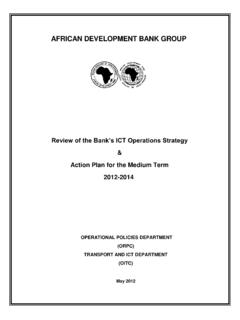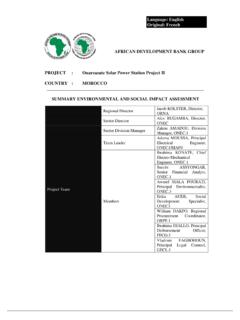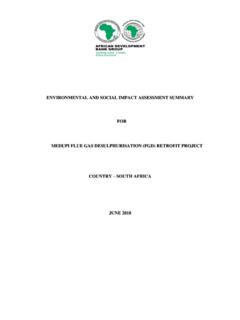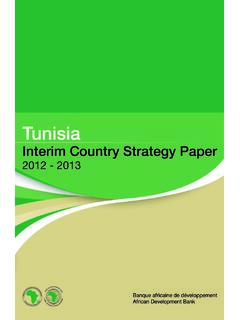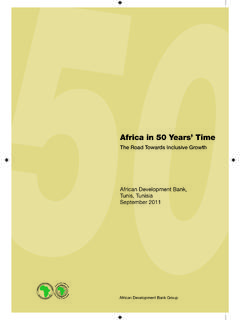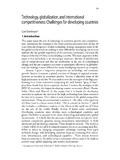Transcription of CAPITAL MARKETS: ROLES AND CHALLENGES
1 Preliminary Draft CAPITAL MARKETS: ROLES AND CHALLENGES # Victor Murinde, University of Birmingham ABSTRACT Globally, the evolution of CAPITAL markets in the last two decades has been dichotomous, in the sense that the markets have experienced integration as well as segmentation. The dichotomous evolution poses important CHALLENGES for the ROLES that these markets can play in emerging economies. This paper aims to examine the ROLES and CHALLENGES of CAPITAL markets, with special focus on Africa. The paper draws on economic theory to assess the potential role of CAPITAL markets, in terms of consumption, investment and economic growth; more specific ROLES with respect to corporate financing, asset pricing and corporate governance are highlighted.
2 It is argued that the macroeconomic policy environment is critical in influencing the performance of CAPITAL markets and hence the extent to which the market may be able to play its role. The status quo of the markets is analysed in terms of stock market capitalisation, number of companies listed, liquidity, returns and volatility of the 20 CAPITAL markets in Africa. The main institutional CHALLENGES are considered in the light of market microstructure evidence on how the frontier CAPITAL markets in Africa are responding to revitalisation and reforms. The paper concludes by pointing out some unresolved issues, undiscovered territory and the future of CAPITAL markets in Africa. JEL Classification No: G10, G15, O55 Key Words: CAPITAL markets; Africa Correspondence to: Professor Victor Murinde Birmingham Business School University of Birmingham University House Edgbaston Birmingham B15 2TT UK.
3 Tel: +44-(0)121-414-6704 E-mail: # This paper is prepared for the International Conference on Accelerating Africa s Development Five Years into the Twenty-First Century , which will be held in Tunis on November 22-24, 2006 under the joint organization of the African Development Bank and the African Economic Research Consortium. The paper draws heavily from my previous papers, including those jointly authored with Christopher J. Green, Robert Lensink, Paul Maggioni, Rose W. Ngugi and Sunil Poshakwale, among others; I am indebted to all of them. Errors are mine. 11. Introduction: the market for CAPITAL finance CAPITAL markets are markets for trading long term financial securities, including ordinary shares, long term debt securities such as debentures, unsecured loan stock and convertible bonds.
4 Government bonds and other public sector securities such as Treasury bills and gilt-edged stocks are also traded on CAPITAL markets. The structure of a global CAPITAL market has three components, as shown in Figure 1. The first is the primary CAPITAL market , for new CAPITAL issues by firms and other institutions, including governments. The second is the secondary market , for the exchange of existing securities. The third is the derivative market , which serves the exchange of securities created by the exchange and whose value is derived from the underlying securities. Hence, it may be argued that, by functional classification, CAPITAL markets play three main ROLES . First, long term funds can be raised by companies from those with funds to invest, such as financial institutions and private investors; in fulfilling this role, they act as primary markets for new issues of equity and debt.
5 Second, CAPITAL markets provide a ready means for investors to sell shares and bonds they own, or to buy additional ones to increase their portfolios; in fulfilling this role, the CAPITAL markets act as secondary markets for trading existing securities. Third, the markets provide mechanisms for trading future and contingent claims, based on the values of the underlying assets; hence the derivatives market . [Figure 1 about here] An important part of the structure in Figure 1 is the complementarity between CAPITAL markets and financial institutions. The evidence uncovered by Demirg -Kunt (1992) is that the existence of an active stock market increases the debt capacity of firms; in this context, equity markets and financial intermediaries complement one another so that an active stock market results in increased volumes of business for financial intermediaries.
6 In addition, it has been argued that the development of stock markets facilitates reforms in the banking sector (Murinde, 1996). It is noted that most problems in the banking sector stem from unbalanced CAPITAL structures in the company sector, especially where equity markets are non-existent (Dailami and Atkin, 1990). Similar conclusions are reached by Demirg -Kunt and Vojislav (1996), who investigate the view that stock market development tends to reduce the volume of bank business. Further, it is shown that initial improvements in the functioning of a developing stock market produce a higher debt-equity ratio for firms making more business for banks. One main lesson from integration of financial markets and institutions in Europe is that the financial system may converge on a bank-based system or on a CAPITAL - market based system, as show by Murinde, Agung and Mullineux (2004).
7 Globally, however, the evolution of the emerging CAPITAL markets in the last two decades has been dichotomous, in the sense the markets have experienced both integration and segmentation. On the one hand, some emerging CAPITAL markets have recorded a dramatic increase in foreign investment due to an expansion in privatisation listings, the use of bond instruments in international debt settlements and some successful implementation of economic stabilisation programmes. The inflows of foreign CAPITAL to the mature CAPITAL markets have enabled these markets to become more integrated with global markets. On the other hand, some very small, less developed CAPITAL markets, which are defined as frontier markets by the International Finance Corporation / Standard & Poors Emerging market Database, have not received much of the foreign inflows.
8 The markets have become consequently segmented from global markets. The dichotomous patterns of integration and segmentation have important consequences for the ROLES that these markets will play in emerging economies, particularly in Africa. 2 This paper aims to examine the ROLES and CHALLENGES of CAPITAL markets, with special focus on Africa. The paper draws on economic theory to assess the role of CAPITAL markets in terms of consumption, investment and economic growth; it then evaluates the corpus of relevant evidence on African markets. It is argued that the macroeconomic policy environment is critical in influencing CAPITAL market and hence the extent to which the market may be able to play its role.
9 The status quo and main institutional CHALLENGES are considered in the light of market microstructure evidence on how the frontier CAPITAL markets in Africa are responding to revitalisation and reforms. The paper concludes by pointing out some unresolved issues, undiscovered territory and the future of CAPITAL markets in Africa. 2. CAPITAL Markets, Consumption, Investment and Economic Growth CAPITAL Markets, Consumption and Investment A simple theoretical underpinning of the role of CAPITAL markets is offered by Copeland, Weston and Shastri (2005), which is an adjusted version of the seminal work by Fisher (1930), Hirshleifer (1970) and Fama and Miller (1972). To illustrate the theoretical exposition, we compare an economy without CAPITAL markets to one with CAPITAL markets and show that in the latter case, no one is worse off and that at least one individual is better off.
10 We consider a simple model, in which all outcomes from investment are known with certainty, there are no transaction costs or taxes and decisions are made in a one period context. Individuals are endowed with initial income, y0, at the start of the period and they have income y1 at the end of the period. Individuals must decide how much to consume now, C0, and how much to consume at the end of the period, C1. The marginal utility of consumption is always positive but decreasing individuals prefer more consumption to less, but the increments in utility become smaller and smaller. The utility of end-of-period is U(C1) while the utility at the start of the period is U(C0). The trade off between consumption today and consumption tomorrow is given by the marginal rate of substitution (MRS): ).


